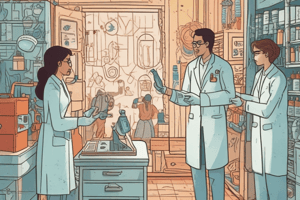Podcast
Questions and Answers
Which of the following diseases can be prevented by vaccines? (Select all that apply)
Which of the following diseases can be prevented by vaccines? (Select all that apply)
- Measles (correct)
- Tetanus (correct)
- Influenza (correct)
- Cancer
Live-attenuated vaccines are derived from disease-causing pathogens that have been weakened.
Live-attenuated vaccines are derived from disease-causing pathogens that have been weakened.
True (A)
What is the purpose of immunization?
What is the purpose of immunization?
To make a person immune or resistant to an infectious disease.
Which type of vaccine uses killed microorganisms?
Which type of vaccine uses killed microorganisms?
The Expanded Program on Immunization (EPI) was established in _____.
The Expanded Program on Immunization (EPI) was established in _____.
Match the following types of vaccines with their examples:
Match the following types of vaccines with their examples:
Flashcards are hidden until you start studying
Study Notes
Immunization
- Immunization is the process of making a person resistant to an infectious disease.
- Vaccines stimulate the immune system to protect against infection.
- Immunization prevents 2-3 million deaths annually and is a cost-effective health intervention that is accessible to all.
Immunity
- Immunity is the state of being protected from a specific disease.
- The body tolerates its own material and eliminates foreign substances.
Expanded Program on Immunization (EPI)
- EPI was founded in 1976 to provide infants, children, and mothers access to routine vaccines.
Vaccines
- Vaccines protect against more than 25 debilitating or life-threatening illnesses.
- Vaccines are categorized based on the antigen used in their preparation.
Types of Vaccines
- Live-attenuated vaccines (LAV)
- Developed in the 1950s.
- Contain weakened pathogens that can grow in the body without causing severe illness.
- Examples: BCG, OPV, Measles, Rotavirus, Yellow fever.
- Inactivated vaccines (killed antigen)
- Contain pathogens that have been killed through physical or chemical processes.
- Unable to cause disease.
- Examples: wP, IPV.
- Subunit vaccines (purified antigen)
- Protein-based subunit vaccines: Present an antigen to the immune system without including viral particles, using a specific isolated protein of the pathogen.
- Examples: aP, HepB.
- Polysaccharide: Examples: Pneumococcal, Meningococcal, Salmonella typhi.
- Conjugate:
- Toxoid vaccines
- Use a harmless version of a toxin (toxoid) to elicit immunity.
- Examples: Tetanus toxoid (TT), Diphtheria toxoid.
Studying That Suits You
Use AI to generate personalized quizzes and flashcards to suit your learning preferences.




